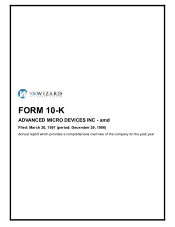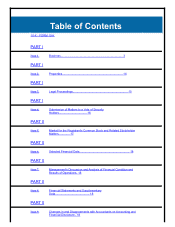AMD 1996 Annual Report Download - page 9
Download and view the complete annual report
Please find page 9 of the 1996 AMD annual report below. You can navigate through the pages in the report by either clicking on the pages listed below, or by using the keyword search tool below to find specific information within the annual report.transmission, then convert signals back to analog on the receiving end. To
perform these tasks, line cards rely on integrated circuit logic products
called subscriber line interface circuits and subscriber line audio processing
circuits.
Logic devices are also used extensively with respect to I/O applications,
which involve the sending and receiving of data from the central processing
unit (CPU) of a PC to peripheral devices such as disk drives and printers, and
multimedia applications, which utilize combinations of sound, graphics,
animation and text.
Manufacturers of electronic systems are increasingly challenged to bring
differentiated products to market quickly. These competitive pressures
sometimes preclude the use of custom designed ASICs, which generally entail
significant design costs and time delay. Standard logic products, an
alternative to custom designed ASICs, limit a manufacturer's flexibility to
adequately optimize and customize an end system. Programmable logic addresses
this inherent dilemma. Programmable logic devices are standard products,
purchased by systems manufacturers in a "blank" state, which can be custom
configured into many specific logic circuits by programming the device with
electrical signals. Programmable logic devices give system designers the
ability to quickly create their own custom logic circuits to provide product
differentiation and rapid time to market. Certain programmable logic products,
including the Company's, are reprogrammable, which means that the logic
configuration can be modified, if needed, after the initial logic programming.
A recent technology development, in-system programmability, extends the
flexibility of standard programmable logic devices by allowing the system
designer to configure and reconfigure the logic functions of the programmable
logic device with a standard 3- or 5-volt power supply without removing the
programmable logic device from the system board.
Several common types of programmable logic devices currently coexist in the
marketplace, each offering customers a particular set of benefits. These
include simple programmable logic devices (SPLDs, less than 1,000 gates),
complex programmable logic devices (CPLDs, up to 20,000 gates) and field
programmable gate arrays (FPGAs, up to 100,000 gates). CPLDs are generally
preferred to FPGAs for control logic applications, such as state machines, bus
arbitration, encoders/decoders and sequencers. FPGAs are generally preferred
to CPLDs for register intensive and data path logic applications, such as
interface logic and arithmetic functions. The Company believes that a
substantial portion of programmable logic device customers utilize both CPLD
and FPGA architectures together to optimize overall system performance and
improve time to market for new products.
THE MICROPROCESSOR MARKET
IBM introduced its first PC in 1981 containing a microprocessor based upon
the x86 instruction set developed by Intel Corporation (Intel) and utilizing
the Microsoft MS-DOS operating system. The so-called IBM-compatible computer
has evolved over the years with each successive generation of x86
microprocessors. Each new generation of x86 microprocessors has delivered
increased performance and functionality while maintaining software, hardware
and peripheral compatibility for industry standard operating systems such as
Microsoft MS-DOS and Microsoft Windows. The microprocessor market is currently
dominated by Intel.
The microprocessor, an IC generally consisting of millions of transistors,
serves as the central processing unit, or "brain," of a computer system. The
microprocessor is typically the most critical component to the performance and
efficiency of a PC. The microprocessor is responsible for controlling data
flowing through the electronic system, manipulating such data as specified by
the hardware or software which controls the system. Microprocessors can be
divided into two broad categories: Reduced Instruction Set Computing (RISC)
and Complex Instruction Set Computing (CISC). Compared to CISC
microprocessors, RISC microprocessors employ an architectural approach that
requires a smaller number of simplified instructions to perform the
microprocessors' internal operations. Developments in circuit design and very
large scale integration process technology have resulted in dramatic advances
in microprocessor performance over the past ten years. Today, the greatest
demand for microprocessors is from personal computer manufacturers and, in
particular, for microprocessors which are Microsoft Windows compatible and are
based on the x86 instruction set. Improvements in the performance
characteristics of microprocessors, coupled with decreases in production costs
resulting from advances in process technology, have broadened the market for
PCs and increased the demand for microprocessors.
5
Source: ADVANCED MICRO DEVIC, 10-K, March 20, 1997






















